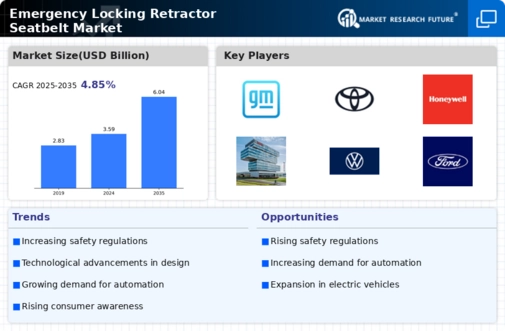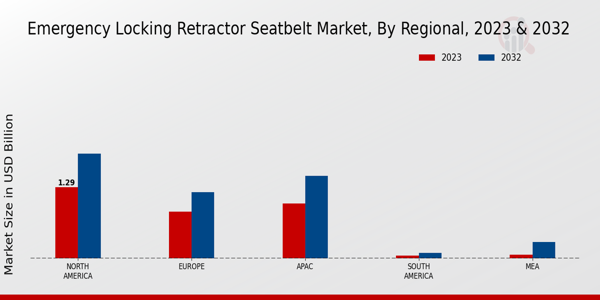Market Growth Projections
The Global Emergency Locking Retractor Seatbelt Market Industry is projected to experience substantial growth over the next decade. With a market value anticipated to reach 6.04 USD Billion by 2035, the industry is poised for expansion driven by various factors, including regulatory changes, technological advancements, and increasing consumer awareness. The projected CAGR of 4.84% from 2025 to 2035 indicates a robust growth trajectory, reflecting the ongoing commitment to enhancing vehicle safety. This growth is likely to attract investments and innovations within the sector, further solidifying the importance of emergency locking retractors in modern automotive design.
Rising Awareness of Road Safety
There is a notable increase in public awareness regarding road safety, which is a crucial driver for the Global Emergency Locking Retractor Seatbelt Market Industry. Campaigns and educational programs aimed at promoting safe driving practices have heightened consumer demand for advanced safety features in vehicles. This shift in consumer behavior is likely to lead to a market growth trajectory that could reach 6.04 USD Billion by 2035. As consumers become more informed about the benefits of emergency locking retractors, manufacturers are responding by integrating these systems into their vehicle designs, thereby enhancing overall safety.
Expansion of Automotive Industry
The expansion of the automotive industry globally is a significant driver for the Global Emergency Locking Retractor Seatbelt Market Industry. As vehicle production increases, so does the demand for advanced safety features, including emergency locking retractors. Emerging markets, particularly in Asia-Pacific and Latin America, are witnessing a surge in vehicle ownership, which is expected to contribute to market growth. This trend is indicative of a broader shift towards safer vehicles, with manufacturers prioritizing the integration of advanced seatbelt systems. The growing automotive sector is likely to sustain the demand for emergency locking retractors in the coming years.
Increasing Vehicle Safety Regulations
The Global Emergency Locking Retractor Seatbelt Market Industry is significantly influenced by stringent vehicle safety regulations imposed by governments worldwide. These regulations mandate the inclusion of advanced safety features in vehicles, including emergency locking retractors. As a result, manufacturers are compelled to innovate and enhance their seatbelt systems to comply with these standards. For instance, the introduction of regulations in various regions has led to a projected market value of 3.59 USD Billion in 2024, reflecting the growing emphasis on passenger safety. This trend is expected to continue, driving the demand for emergency locking retractors in the automotive sector.
Technological Advancements in Seatbelt Systems
Technological innovations play a pivotal role in shaping the Global Emergency Locking Retractor Seatbelt Market Industry. The development of smart seatbelt systems that incorporate sensors and automated locking mechanisms enhances the functionality and reliability of seatbelts. These advancements not only improve passenger safety but also align with the growing trend towards automation in vehicles. As manufacturers invest in research and development, the market is poised for growth, with a projected CAGR of 4.84% from 2025 to 2035. This technological evolution is likely to attract consumers seeking the latest safety features in their vehicles.
Consumer Preference for Enhanced Safety Features
Consumer preferences are increasingly leaning towards vehicles equipped with enhanced safety features, which significantly impacts the Global Emergency Locking Retractor Seatbelt Market Industry. As buyers prioritize safety in their purchasing decisions, manufacturers are compelled to incorporate advanced seatbelt technologies into their vehicles. This shift is evident in the growing market value, which is projected to reach 3.59 USD Billion in 2024. The demand for emergency locking retractors is expected to rise as consumers become more discerning about the safety features offered in their vehicles, thereby driving innovation and competition among manufacturers.












